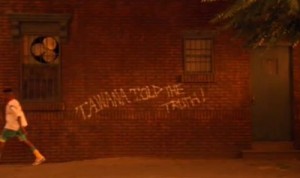The one thing that really intrigued my about Do The Right Thing (Lee, 1989), was the Cinematography in the scene where Radio Raheem tells “the story of love an hate”, specifically the actor Bill Nunn’s bodily movements in his performance and blocking within the film’s mis-en -scéne.
When Radio Raheem begins his monologue he holds up his right fist where the “Love” ring is when he says “let me tell you the story of love and hate” and then his left fist where the “Hate” ring is when he says the word “hate”. I think that was a intelligent movement on his end because not only does it engaged the viewer, but it also provides viewers with visual aids of love and hate and further shows their relationship when Radio Raheem depicts the relation between the two with both his fists. It is clear from the beginning here that bodily movement is integral in this scene.
I also thought it was really interesting that Lee decided blocking wise to position Radio Raheem in the middle of the frame facing the camera. This suggest that there is an interesting hybrid between graphic blocking and social blocking. This is so because While Mookie is not in the frame, the audience understands that Radio Raheem is talking to Mookie, which gives the viewers this impression that while according to the story line Radio Raheem is talking to Mookie, Radio Raheem is actually speaking to the audience.
Above all, this scene stuck out to me the most in the film because of its strategic use in both blocking and the actor’s performance, specifically with bodily movement.

